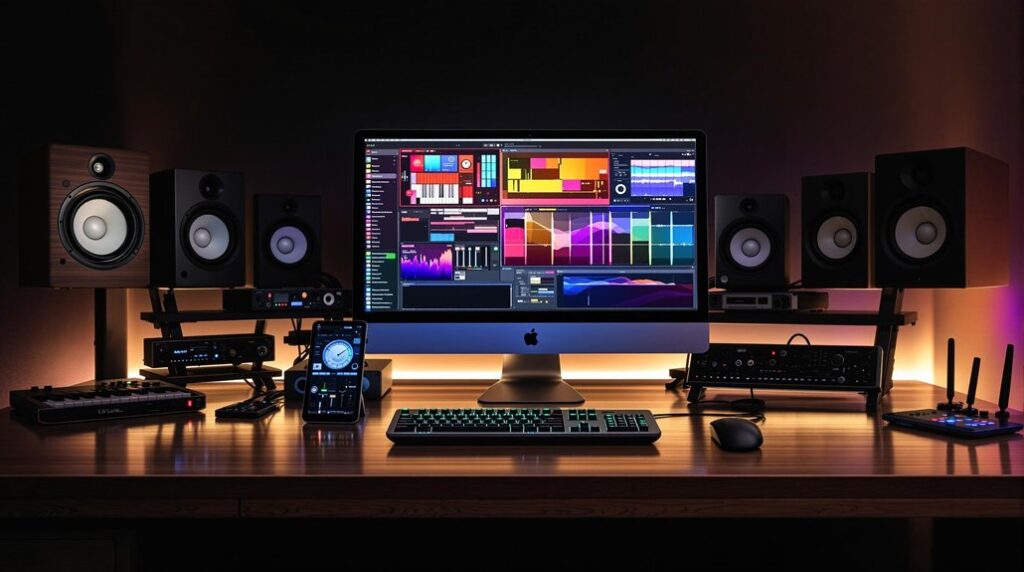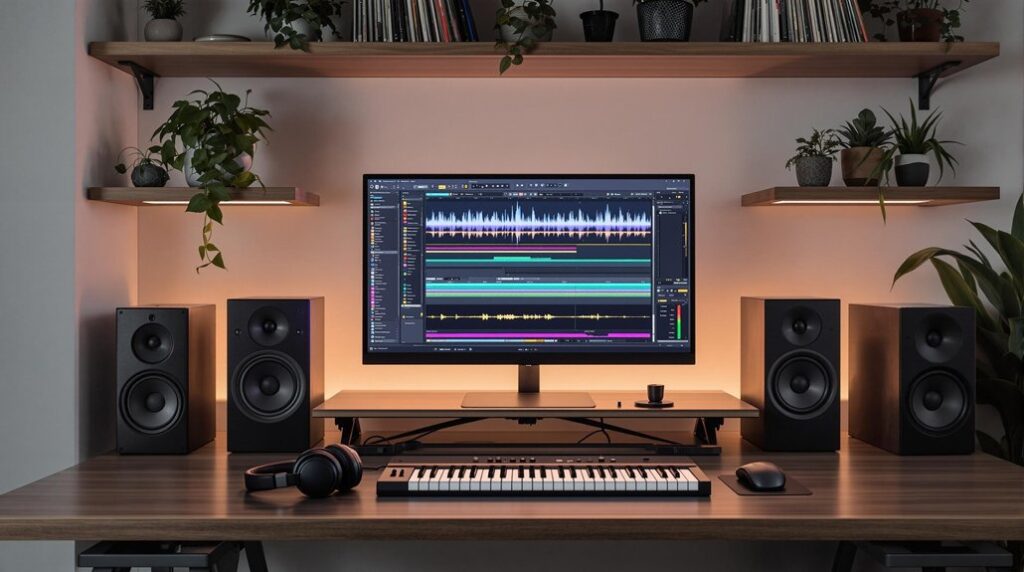To create a beat in Ableton, follow these three steps. First, select and organize your sounds using the Ableton Live browser. Choose iconic drum kits, configure a MIDI track with a drum rack, and create a solid foundation. Next, lay down your drum pattern by placing kick drums, handclaps, and offbeat hi-hats to establish rhythm. Finally, refine your beat with groove enhancements by applying swing and adjusting velocities to achieve a natural feel. These techniques will improve your track effectively. Discover more strategies to enhance your production skills and take your beats to the next level.
Key Takeaways
- Start by selecting and organizing sounds in Ableton Live’s browser, choosing a drum rack for layered sampling.
- Create a basic drum pattern using kick drums, handclaps, and offbeat hi-hats for rhythm.
- Enhance your groove by adjusting swing, varying velocities, and applying quantization as needed for a more organic feel.
- Experiment with different patterns in Session View to find unique combinations and maintain musicality.
- Finalize your beat by reviewing elements for balance, adding effects, and exporting in your desired format.
Selecting and Organizing Sounds
When starting on the journey of beat-making in Ableton, it is essential to begin by selecting and organizing sounds effectively.
Navigate to the Ableton Live browser on the left side of the interface to access an extensive array of sounds, including pre-made drum kits and audio effects.
Utilize the Session View for capturing spontaneous ideas, while the Arrangement View allows for structured track organization; switch between these by pressing the Tab key.
Preview different drum sounds, such as iconic kick drums from the Roland 909, to ascertain they align with your desired style.
Create a MIDI track and employ a drum rack to layer various sounds, where each key corresponds to a different drum sound, enhancing your creative possibilities. Additionally, remember to configure Ableton Live for VST plugins to broaden your sound selection options.
Laying Down the Drum Pattern
Establishing a solid drum pattern is essential for creating a compelling beat in Ableton. Start by creating a MIDI track and loading a drum rack to access your sampled drum sounds.
Follow these steps:
- Place kick drum notes on beats 1, 2, 3, and 4 to form the foundational rhythm.
- Add handclaps on the second and fourth kick placements to enhance the backbeat.
- Introduce offbeat hi-hats between the main beats for added dynamic rhythm.
You can choose between closed or open hi-hats for variation. Additionally, make sure to utilize Session View to easily launch and manipulate your drum patterns as you develop your beat.
Once you’re satisfied, use the duplicate loop function to extend your pattern. If you feel it’s not quite right, don’t hesitate to go back and adjust elements, ensuring your drum pattern is effective for your music production goals.
Refining and Adding Groove
Enhance your beat by refining the drum pattern and adding groove, which will boost the overall feel of your track. To get ready to start, explore groove files that subtly shift notes off the grid for a more natural rhythm. Apply MPC-style swing to achieve a vintage drum machine effect, enhancing the groove.
Make sure to utilize the preview function to test different swing amounts before committing. Additionally, vary the velocity of hits, especially hi-hats and snares, to create an organic rhythm. Consistently listen to your adjustments for cohesion and interest. Using dynamic EQ can help tailor the frequencies of your drum sounds for even greater clarity in the mix.
| Element | Action | Goal |
|---|---|---|
| Groove Files | Shift notes off-grid | Natural feel |
| MPC Swing | Apply to drum pattern | Vintage effect |
| Velocity | Vary hits | Organic rhythm |
Frequently Asked Questions
How to Make Beats Step by Step?
To achieve effective beat creation, start by selecting a drum kit, establish foundational rhythm patterns with kick drums, layer additional percussion, utilize loop duplication, and apply swing for a dynamic and engaging sound. Adjust velocities for nuance.
Can You Make Beats With Ableton?
Yes, you can create beats using Ableton. Its features, including drum racks, MIDI tracks, and various drum sounds, facilitate dynamic beat creation. Explore loop duplication and velocity adjustments for engaging and professional-sounding music production.
What Do Most Artists Use to Make Beats?
Most artists utilize popular DAWs such as Ableton Live, FL Studio, and Logic Pro for beat making. These versatile software options offer unique features, catering to varied genres and enabling efficient, creative music production processes.
How to Loop a Beat in Ableton?
To effectively loop a beat in Ableton, utilize looping techniques by creating a MIDI clip, duplicating it for beat variations, and adjusting the loop length in clip view to guarantee continuous playback. Activate the loop switch for seamless repetition.
Conclusion
To summarize, creating a beat in Ableton can be accomplished efficiently through a structured approach. By selecting and organizing sounds, laying down a foundational drum pattern, and refining the composition with added groove, users can produce a polished track. This streamlined process not only enhances creativity but also facilitates the exploration of individual style. Mastery of these steps fosters confidence and proficiency in music production, making it accessible for both beginners and experienced producers alike.




